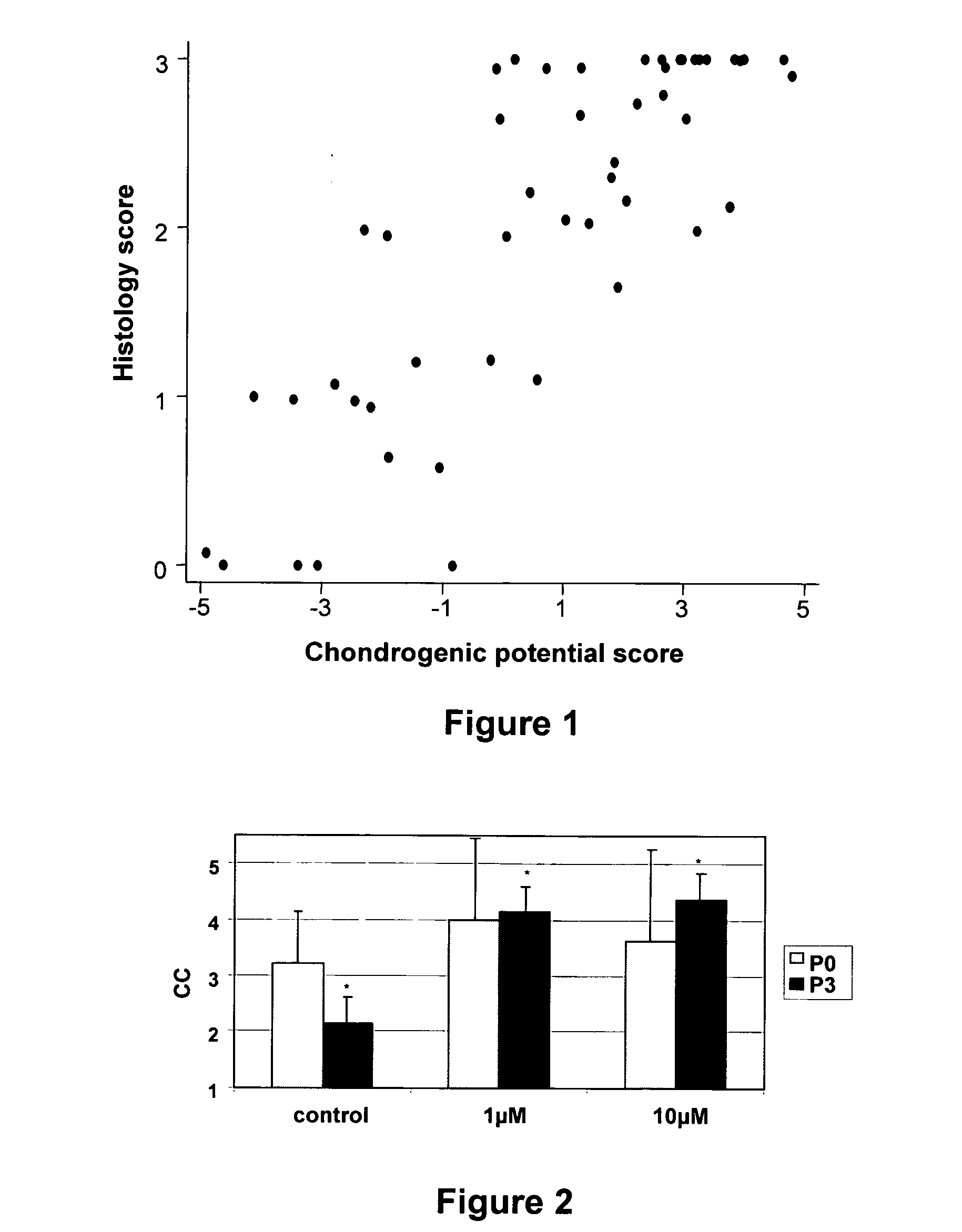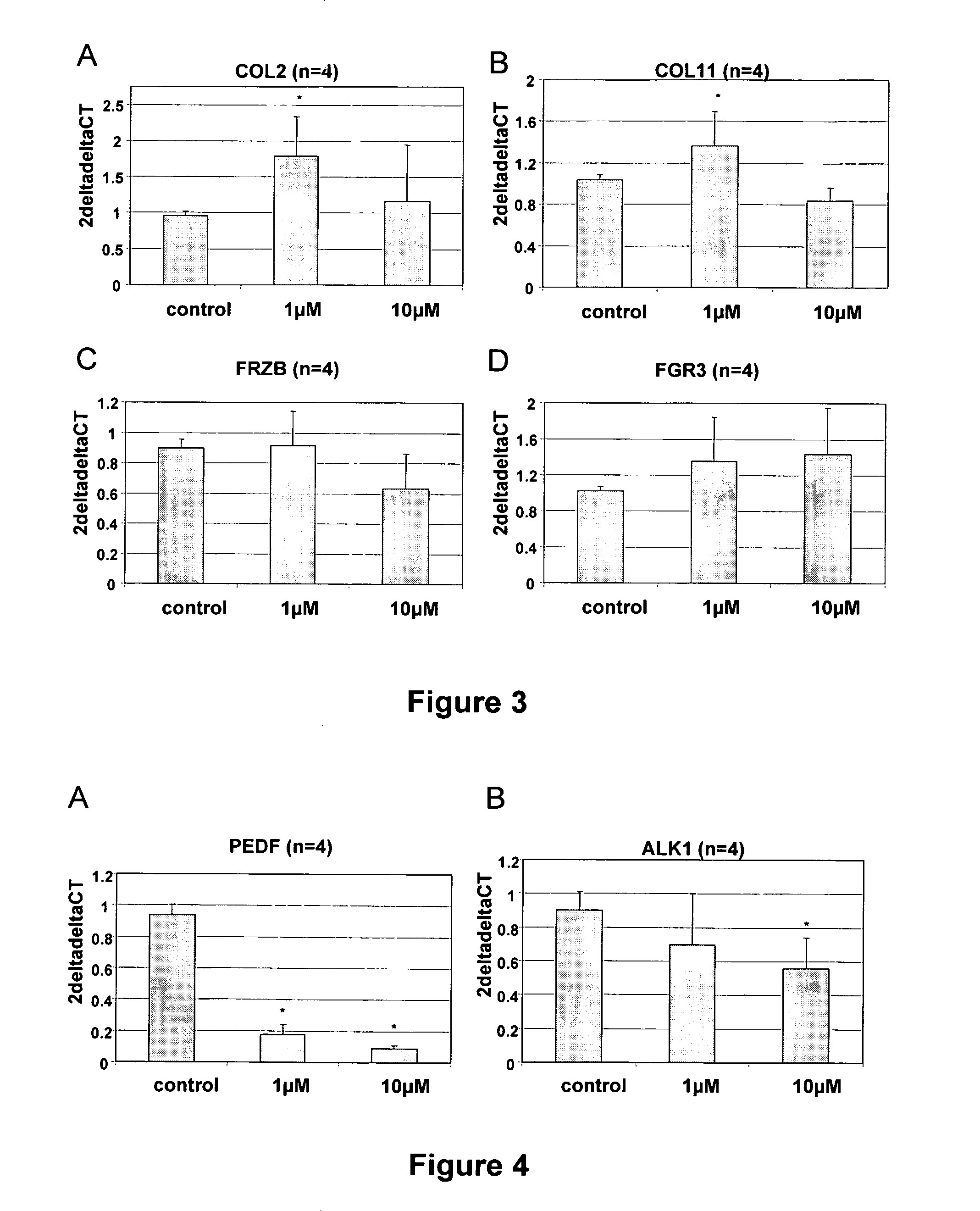Marker genes for use in the identification of chondrocyte phenotypic stability and in the screening of factors influencing cartilage production
- Summary
- Abstract
- Description
- Claims
- Application Information
AI Technical Summary
Benefits of technology
Problems solved by technology
Method used
Image
Examples
example 1
[0101]A fraction of the injected cells was used for gene expression analysis. RNA isolation, reverse transcription and PCR were performed using the methods described in WO0124832. PCR primers for these markers are shown in Table1.
TABLE 2Primers for the amplification of marker genesPrimerSequenceSEQ ID. NO:beta actinforward5′-tgacggggtcacccacactgtgcccatcta-3′1reverse5′-ctagaagcatttgcggtggacgatggaggg-3′2Collagen 11forward5′-gaactccatctctccctgc-3′3reverse5-gagactggatttcaaggcaag-3′4Collagen 2forward5′-ccctgagtggaagagtggag-3′5reverse5′-gaggcgtgaggtcttctgtg-3′6PEDFforward5′-ttcaaggggcagtgggtaac-3′7reverse5′-taaggtgatagtccagcggg-3′8Frzb1forward5′-tgtaagtctgtgtgcgagcg-3′9reverse5′-gatttagttgcgtgcttgcc-3′10 ALK1forward5′-cgacggaggcaggagaagcag-3′11 reverse5′-tgaagtcgcggtgggcaatgg-3′12 FGFR3forward5′-gctgaaagacgatgccactg-3′13 reverse5′-aggaccccaaaggaccagac-3′14
[0102]The expression levels of the markers are determined by measuring the intensity of PCR products after electrophore...
example 2
[0104]The correlation between the Chondrogenic potential score as determined in Example 1 and the histology score is depicted in Table 3 and in FIG. 1. The correlation coefficient between the Chondrogenic potential score and histology score is 0.78 and statistically significant (p<0.0001).
[0105]Samples with a Chondrogenic potential score of −3 or lower always result in fibrocartilage or no cartilage at all. Samples with a Chondrogenic potential score of 2 or more will always result in hyaline cartilage. Samples with a Chondrogenic potential score of 1 results in 1 out of 6 cases into hyaline cartilage.
[0106]As a yardstick, a sample with a Chondrogenic potential score of 0 or more is considered to be suitable for implantation. Based on the present data set it is possible to predict in 77% (37 / 48) the outcome of a transplantation with high certainty and in 64% without errors. Based on this data set, a chondrocyte culture is approved for use in an ACI procedure when the Ch...
example 3
Impact of Individual Markers
[0118]The impact of individual markers is assessed by recalculating the expression profile of 5 markers instead of 6 markers of the set of markers determining the Chondrogenic potential score in Example 1. The same scoring system was applied, wherein scores now can range from −5 to +5.
[0119]Data are presented in Tables 4 to 9.
TABLE 4Frequency table for histology score without COL11 markerMarkerHistology scorescore0123Total−5 0−4 123−3 314−2 1416−1 11130113515510238113134411511total59122248
TABLE 5Frequency table for histology score without COL2 markerMarkerHistology scorescore0123Total−5−4112−3213−21315−121140125816511237103123422559122248
TABLE 6Frequency table for histology score without PEDF markerMarkerHistology scorescore0123Total−5−411−3314−2112−112140325124621359325742810559122248
TABLE 7Frequency table for histology score without FRZB markerMarkerHistology scorescore0123Total−511−4213−3213−2314−112126012311581423693123422559122248
TABLE 8Frequency tab...
PUM
| Property | Measurement | Unit |
|---|---|---|
| Volume | aaaaa | aaaaa |
| Fraction | aaaaa | aaaaa |
| Fraction | aaaaa | aaaaa |
Abstract
Description
Claims
Application Information
 Login to View More
Login to View More - R&D
- Intellectual Property
- Life Sciences
- Materials
- Tech Scout
- Unparalleled Data Quality
- Higher Quality Content
- 60% Fewer Hallucinations
Browse by: Latest US Patents, China's latest patents, Technical Efficacy Thesaurus, Application Domain, Technology Topic, Popular Technical Reports.
© 2025 PatSnap. All rights reserved.Legal|Privacy policy|Modern Slavery Act Transparency Statement|Sitemap|About US| Contact US: help@patsnap.com


